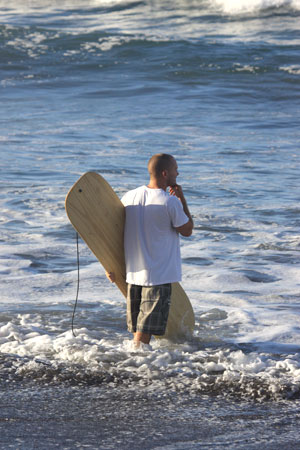 |
|
There has been a recent rebirth of some very ancient wave riding vehicles, and everyone seems to be getting in on the action. Tom and Jon Wegener, a couple of brothers from Australia, have breathed new life into a form of surfing that died in the early 1900’s. The Alaia, and some of their other finless hybrid models are flying off the shelves faster than the guys can make them. I had them make one for me and a friend, and we’re stoked.
The boards themselves can vary, but a typical Alaia is a very thin, square tailed plank of wood that has no keel fin. The only way to direct the board is by planting the rail firmly in the crest of the wave, setting your line, and hoping you don’t slide out or have to beat any sections down the line. The current preferred wood is known as Paulownia wood, and it is very supple, closed-cell wood that won’t soak in water. The previous Hawaiian made models used koa wood primarily, and there were other models known as Olo’s (18’-24’ in length), and Paipo’s (belly and knee riding board, made even smaller). However the Alaia is the one currently being brought back to the surfing world.
The act of riding an Alaia in spoken Hawaiian, is called La-La. According to written sources and the ancient Hawaiian dictionary, La-La is ‘the controlled slide in the curl when surfing on a board.’ The feeling these boards give is completely different than normal surfing. One can actually feel the water pushing beneath their feet on the wave, and the speed you can generate by simply locking the rail is unparalleled. While the takeoff is tricky, and probably the most difficult part of Alaia surfing, once you get past that, the overall experience is pretty cool. Don’t bother trying to jockey for waves either, as there is no float whatsoever in the board, and you’re basically swimming in the water on a neutrally buoyant piece of wood. Also, surfing the board in Guiones can be difficult if the conditions aren’t perfectly peeling, so some of the other steeper breaks around the area can work better, and on the days with offshore winds.
So, if you’re looking for a challenge, and a new perspective on wave riding, try to get your hands on one of these boards. You can try the traditional Alaia, or one of the other models like the Blue Gill, seen in some of the photos here. If you’re patient and keep at it, it’s a ton of fun!!
|

